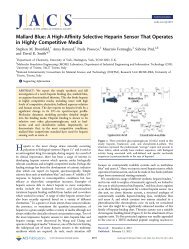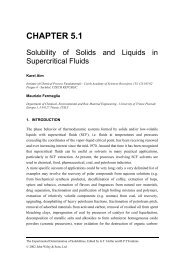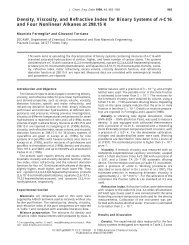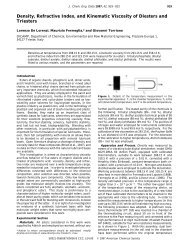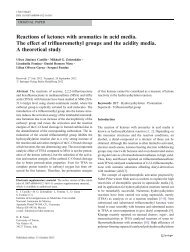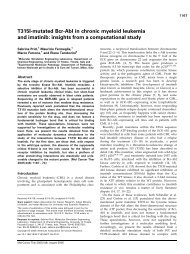Hydrogen sulphide removal from biogas by zeolite ... - Mose
Hydrogen sulphide removal from biogas by zeolite ... - Mose
Hydrogen sulphide removal from biogas by zeolite ... - Mose
Create successful ePaper yourself
Turn your PDF publications into a flip-book with our unique Google optimized e-Paper software.
P. Cosoli et al. / Chemical Engineering Journal 145 (2008) 86–92 87the differences encountered in a realistic situation, when a <strong>biogas</strong>mixture of CO 2 ,CH 4 , and H 2 S at low pressures is considered. Finally,isosteric heats of adsorption, total energy contributions and energydensities were the selected quantities to investigate adsorptioncompetition at different pressures, and <strong>zeolite</strong> selectivity [22].2. Materials and methodsSimulations were carried out on an Intel bi-processor XEON32bit workstation. We used Sorption and DMol 3 software modulesof Materials Studio (v. 4.0, Accelrys, San Diego, CA, USA), and inhousedeveloped software. Stochastic methods have been describedin our previous work [23] or elsewhere [24,25]; hence, here we willonly briefly describe Metropolis [16] and Configurational Bias [26]methods.Generally speaking, during a sorption simulation the chemicalpotential is kept fixed, creating a certain number of configurationsof molecules to be adsorbed on a given framework. In theGrand Canonical ensemble, the chemical potentials of all componentsand the temperature are fixed as if the framework is in opencontact with an infinite sorbate reservoir at a given temperature.The reservoir is completely described <strong>by</strong> temperature and fugacityof all components, and does not have to be simulated explicitly.Chemical potentials for each component are related to the fugacity(or partial pressure) f of the components; the reservoir, in thisstudy, is always treated as an ideal-gas system, due to the low bulkpressures taken into account, thus, partial pressures have been considered.Molecules can be created, translated, rotated or destroyed. Equilibriumis reached when temperature and chemical potential ofthe external reservoir (i.e., free gas outside the framework) and theframework are equal. The Metropolis sampling method generateschain of configurations with the ensemble probability. Transforminga configuration involves a random displacement of each atomin the system <strong>from</strong> its actual position; as in this case sorbates areflexible, trajectories are employed (see Additional Information). Atrial move is accepted if it lowers the configuration energy of thesystem. If the configuration energy is increased, trials are acceptedwith a probability proportional to a Boltzmann factor: P =e −U/kT ,where U is the configuration energy difference. Configurationalbias (CBMC) methods are widely used to simulate adsorption ofrather large and flexible molecules. In a CBMC sorption simulation,a bias is introduced towards high energy values, to avoid attemptof sampling configurations with low probabilities, which are likelyto be rejected <strong>by</strong> the acceptance test [26].In this work, adsorbed molecules are rather small if comparedto all <strong>zeolite</strong> pore size; nevertheless, we decided to test both methods.Since the results for <strong>biogas</strong> adsorption isotherms in <strong>zeolite</strong>sobtained with Metropolis Monte Carlo (MMC) and CBMC revealednegligible differences (see Supplementary material), we decidedto adopt the MMC technique, being computationally faster thanCBMC. H 2 S molecular model has been built and optimized at QMdensity functional theory (DFT) [27] level with the DMol 3 module,due to its flexibility and dipole moment; structures of thesymmetrical CH 4 and symmetrical and linear CO 2 molecules havebeen minimized, and partial charges assigned <strong>by</strong> the selectedForce Field, the cvff aug (consistence valence augmented forcefield).Four <strong>zeolite</strong>s were considered: LTA, FAU NaX, FAU NaY, and MFI.The first three frameworks are hydrophilic, and already employedfor H 2 S adsorption [12,28,29]. The last one, MFI, is hydrophobicin nature, and has been taken into account to investigate adsorptiondifferences between these categories. 3D molecular models ofLTA (Si/Al = 1), NaX (Si/Al = 1), NaY (Si/Al = 2.5) and dealuminatedMFI [30] were available in the structural database of Materials Studio.Aluminum substitutions have been performed <strong>by</strong> followingLoewenstein’s rule [31], while Na + ions position has been assigned<strong>by</strong> in-house developed software for identifying potential energyminima and, thus, most probable extra-framework cation positions.An all-atom model has been chosen for calculation; the cvff augwas the potential energy expression of choice in all calculations[32]; a more detailed description of all molecule models is given inAdditional Information. Electrostatic energy terms have been computed<strong>by</strong> the Ewald summation method. van der Waals interactionshave been calculated with the classical Lennard–Jones function[33]; the cut off for van der Waals contribution, has been set to8.5 Å, with an atom based calculations and cubic spline truncation;the cut-off distance should be less than a half of the minor cellside, so when necessary (<strong>zeolite</strong> MFI) we duplicated cells. The cubicspline truncation was set to 1 Å with a buffer of 0.5 Å; in this way,the van der Waals non-bond energy term is splined <strong>from</strong> its fullvalue to zero within a radio of 1 Å. For electrostatic contributions,the accuracy of Ewald and group calculation was 0.001 kcal/molwith the same cut off and buffer. At least 1 × 10 7 productive MonteCarlo steps (i.e. Monte Carlo trial moves), preceded <strong>by</strong> 1 × 10 6 equilibrationsteps, have been performed under 3D periodic boundaryconditions. Overall, we performed and compared MMC for pure H 2 Sadsorption (<strong>from</strong> 10 up to 1000 Pa), and competitive, simultaneousadsorption of H 2 S, CH 4 and CO 2 , with partial pressure in the rangeof a typical <strong>biogas</strong> (CO 2 and CH 4 with low concentrations of H 2 S)and a bulk pressure P total = 1 atm. The simulation temperature wasfixed at 298 K, which is a realistic temperature for a <strong>biogas</strong> exiting<strong>from</strong> a mesophilic process [1,2,6].Adsorption thermodynamics were further investigated analyzingthe values of the isosteric heat of adsorption, Q RF , which is ameasure of adsorption capabilities of a sorbate in an adsorbentframework. Q RF is defined as the difference between the partialmolar enthalpy of the sorbate component in the external reservoir(i.e., free gas) and in the framework; accordingly, it is a measureof the enthalpy change involved in the transfer of a solute <strong>from</strong>the reference state to the adsorbed state at a constant solid phaseconcentration [34]:Q RF = h R − h F (1)Evaluation of Q RF requires the application of Clausius–Clapeyronequation [34]:[ dp] [ d(ln p)]Q RF = (v S − v F )∼= RT (2)d(ln T) d(ln T)where v R and v F are the sorbate partial molar volumes in the reservoirand in the framework, respectively, p the partial pressure, andT the temperature. In the right-hand side term of Eq. (2), the partialmolar volume of the gas molecules in the framework is neglectedwith respect to that in the reservoir, and the gas behavior in thereservoir is assumed to be ideal. This leads to the expression of Q RFin the Grand Canonical ensemble, where the free energy G can becalculated:Q RF = RT − G (3)A further criterion for investigating adsorption is given <strong>by</strong> theanalysis of the total energy components of the system and theenergy distributions. In the first case, the total energy E M of a specificconfiguration of the simulation, M, is given <strong>by</strong> the Coulomb (i.e.,electrostatic) and van der Waals (i.e., dispersion) contributions:E M = E SSM + ESF M + US M (4)where E SSMmolecules, E SFMis the intermolecular energy between the sorbateis the interaction energy between the sorbate




